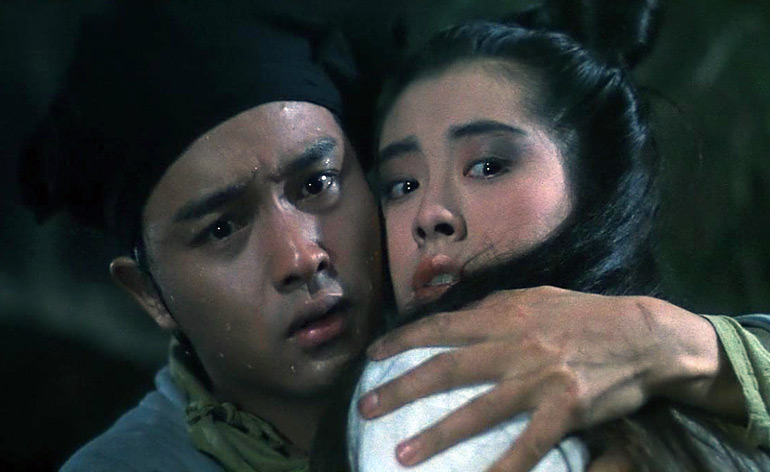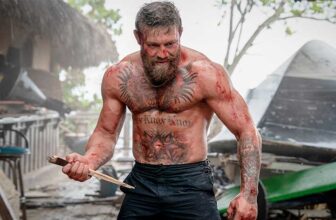
Romantic comedy horror film starring Leslie Cheung, Joey Wong and Wu Ma, directed by Ching Siu-tung and produced by Tsui Hark. The plot was loosely based on a short story from Qing dynasty writer Pu Songling’s “Strange Stories from a Chinese Studio”, and also inspired by the 1960 Shaw Brothers Studio film “The Enchanting Shadow”.
Trailer
Cast
Leslie Cheung stars as “Ling Choi-san”, a debt collector who falls in love with a beautiful ghost. A Hong Kong singer, actor and film producer, he is considered as “one of the founding fathers of Cantopop”. He is probably best remembered for his breakthrough role in John Woo’s “A Better Tomorrow”, and achieved great acclaim for his performances in “Rouge”, and Wong Kar-Wai’s “Days of Being Wild”. He sadly took his own life in 2003 aged just 46 years old. He left a suicide note saying that he had been suffering from depression.
Joey Wong plays “Nip Siu-sin”, a ghostly spirit that is forced to lure young men to their death for the Tree Demon. Originally from Taiwan, her success in this film led to her becoming something of an idol, especially in Japan and South Korea. She would go on to appear in Jackie Chan’s “City Hunter”, “Butterfly and Sword”, “The Banquet” and two sequels to “A Chinese Ghost Story”.
Veteran character actor Wu Ma stars as “Yin Chik-ha”, a Taoist warrior priest that hunts ghosts. Wu Ma made his screen debut in 1963, and with over 240 appearances to his name (plus 49 directorial credits within a fifty-year period), he was one of the most familiar faces in the history of Hong Kong Cinema. Martial arts fans will recognise him from films such as “The Prodigal Son“, “Encounters of the Spooky Kind“, “Twinkle Twinkle Lucky Stars” and “Mr Vampire“, to name just a tiny few.
Lau Siu-ming is in drag as “The Tree Demon”, an evil spirit that forces Nip Siu-sin to lure men so as to feed on their life force. Lau Sing-Ming is a respected veteran actor and a pioneer in Hong Kong dance. As a youngster, Lau received a scholarship to study ballet in France and work with some of the top dancers in the world. He went on to become the first Chinese dance choreographer in France and a founding member of the Hong Kong Dance Federation. Often working for Tsui Hark he has appeared in “Royal Warriors”, “Righting Wrongs”, “A Better Tomorrow II”, “Swordsman” and “Fearless“.
Plot
Ling Choi-san is an ineffectual young tax collector. As such, nobody will offer him a bed for the night, so he is forced to seek shelter at a reputedly haunted temple on the outskirts of town. There he meets the warrior monk Yin Chik-ha and the beautiful Nip Siu-sin.
Ling falls in love with her, unaware that she is a ghost sent forth by an evil demon to tempt men and steal their lifeforce. Revealing her fate to Ling Choi-san, Nip tells him her story of how she became eternally bound to the servitude of a sinister Tree Demon. She explains that as long as her remains are buried at the foot of the tree, her spirit will be forever enslaved by the Tree Demon.
Desperate to rescue Nip, Ling insists that Yin help him. Yin manages to open a temporary portal to the Underworld. Ling and Yin journey to the Underworld where they attempt to free Nip’s soul.
Action
A short introductory scene sets the tone for what is to come in terms of action, with flashing blades, beheadings and fast edits.
Wu Ma’s first battle is a night time duel. The choreography is fast and fluid, with lots of spinning and twirling, sometimes on wires. A wind machine is used to blow fallen leaves across the screen, adding atmosphere and energy to the scene.
Our first view of the supernatural action comes with Joey Wong seducing a vulnerable swordsman in the woods. Using a combination of “Evil Dead” style camera work and old-school practical effects, the swordsman meets a grisly end.
Wu Ma encounters Joey Wong’s spirit in the woods and a flying battle through the trees ensues. Beautifully lit in its night time setting, the choreography is heavily reliant on the use of wires. However, whereas this can occasionally appear over-the-top in movies such as “Butterfly and Sword”, here it adds to the supernatural setting of this tale.
The undead in this film are much creepier than the usual hopping vampires, looking like drained skeletal corpses, not unlike the ghostly forms taken by the cursed pirates in the “Pirates of the Caribbean: The Curse of the Black Pearl”. Using a mixture of actors in make up and stop-motion animation, they menacingly stagger after their prey.
In a bizarre but very entertaining sequence, Wu Ma performs a Jianshu (straight sword) routine whilst singing a rap version of “The Way”, a Taoist song! The high technical skill of the practical effects team is put to good use in a set-piece where a giant tongue tries to devour Leslie Cheung and Joey Wong in a wooden house. As our leads try to escape the creepy, malevolent tongue, leaves and debris from the splintering wood swirl and swoop around them. When Wu Ma faces the Tree Demon, the fantasy action-choreography gives the audience plenty of “gross-out” moments, as the giant tongue splatters slimy goo in the faces of the heroes.
The final battle in the underworld is both atmospheric and energetic. Dozens of arms punch through dusty walls grabbing at the smitten lovers, whilst Wu Ma battles ghostly warriors with his martial arts and bow and arrows. Shot in a virtually empty, blacked out studio, the low camera angles and lighting of the smoky background give the underworld setting an appropriately eerie ambiance.
Summary
If “Encounters of the Spooky Kind” re-invigorated the Chinese horror comedy genre in the 1980’s, and the “Mr Vampire” movies defined it, then “A Chinese Ghost Story” gave it its heart.
Amidst the craziness of the supernatural goings-on, simplistic comedy and physics-defying action, there is a tender love story, beautifully told in the performances of Joey Wong and Leslie Cheung.
Wu Ma arguably gives one of the best performances of his prolific career, in a rare role as the action lead. Even though much of the film takes place at night, it is still very well lit and shot. The director uses all sorts of camera techniques and “Dutch Angles” (camera tilts), creating a unique look, that would be copied by many of the Chinese fantasy films that were to follow it. Whereas “Encounters of the Spooky Kind” focused on traditional martial arts action, and “Mr Vampire” primarily used slapstick comedy, “A Chinese Ghost Story” presents the action in a highly stylised, hyperreal fashion.
The use of wires and swordplay choreography would feature heavily in director Ching Siu-tung’s later work on movies such as “The Swordsman” series, “New Dragon Gate Inn“, “Hero” and “House of Flying Daggers“, and influenced many other similar films. It is easy to understand why this film was a success on the international festival circuit and is considered a masterpiece of modern Chinese cinema. In its day, and even now, it has an incredible look to it.
For martial arts purists who don’t mind wire-work, the action in Ching Siu-tung’s later works, or even something like “Iron Monkey” starring Donnie Yen, would probably be more satisfying. But if you want to watch a unique, atmospheric and highly-influential Chinese film, “A Chinese Ghost Story” is a must-see for fans of Asian cinema.
Trivia
- Lead actor Leslie Cheung spoke fluent English having studied at Leeds University in the UK.
- In 1997 Tsui Hark wrote and produced an animated version of “A Chinese Ghost Story”.
- At the 7th Hong Kong Film Awards, the film received nominations for Best Action Choreography, Best Actress for Joey Wong, Best Supporting Actor for Wu Ma, Best Picture, Best Editing and Best Cinematography. It won awards for Best Art Direction, Best Original Score and Best Original Song.
- Director Ching Siu-tung, who had been trained in Peking opera as a child, made his directorial debut in 1982 with the ground-breaking wuxia classic “Duel to the Death”. The action choreography redefined how Chinese swordplay movies were made.
- The plot was taken from “Strange Stories from a Chinese Studio” or “Liaozhai Zhiyi”, a collection of nearly 500 mostly supernatural tales written by Pu Songling during the early Qing dynasty.
- The film was remade in 2011 directed by Wilson Yip (SPL: Sha Po Lang/Kill Zone, Dragon Tiger Gate, Flash Point and Ip Man trilogy), and starring Louis Koo, Liu Yifei, Yu Shaoqun, Kara Hui, Louis Fan, and Wang Danyi Li.






